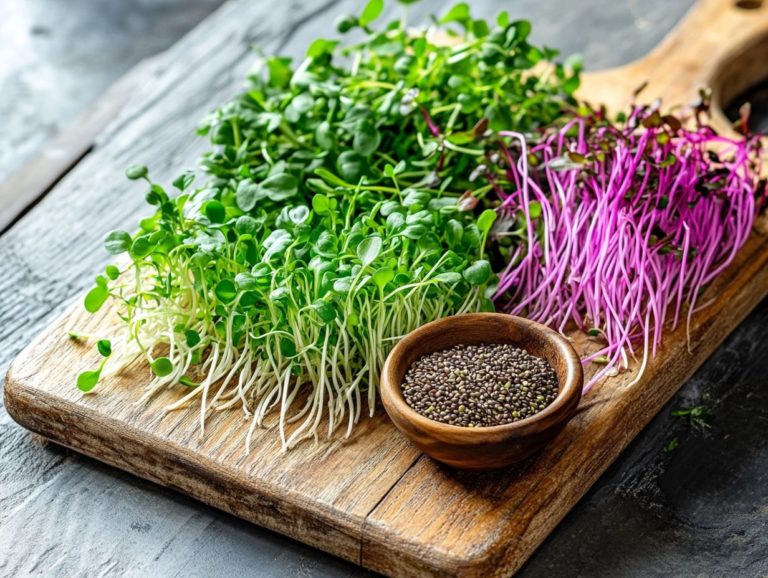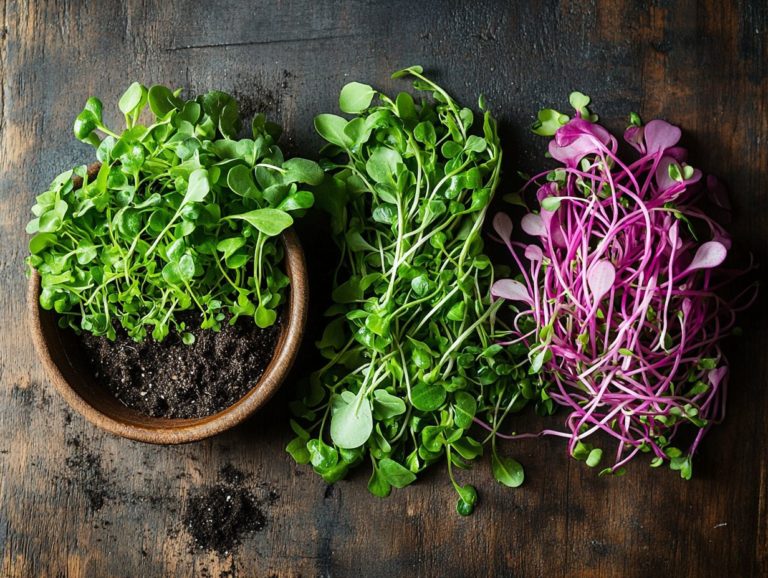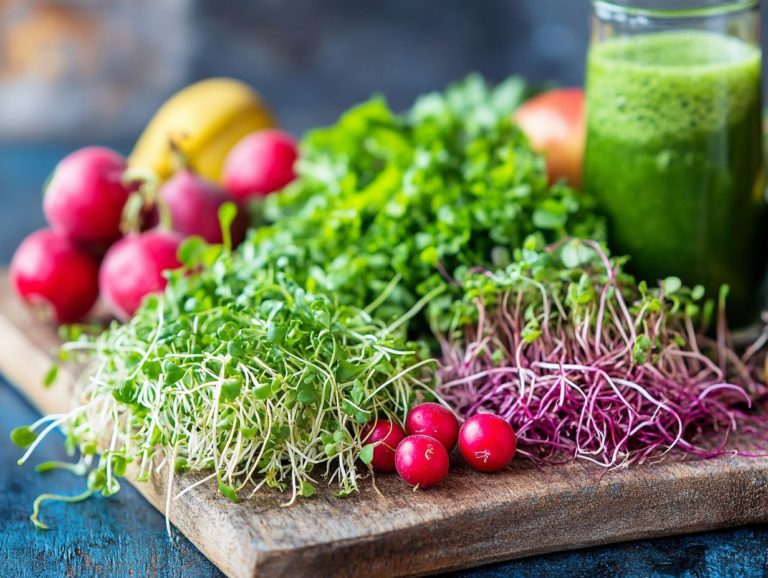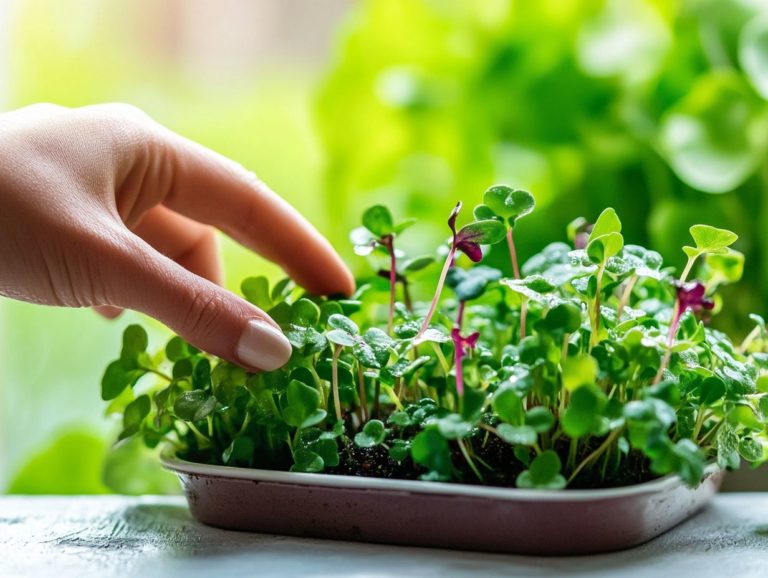The Nutritional Advantages of Microgreens for Kids
Microgreens are tiny, nutrient-packed wonders that can transform the way your kids approach eating.
Often overlooked, these little greens deliver a powerful punch of flavor and health benefits. This article dives into what microgreens are, showcases their impressive nutritional value compared to other greens, and demonstrates how they can enhance your child’s diet.
Discover exciting ways to add microgreens to your meals, along with fun activities for growing your own. We cover everything you need to know to make microgreens a colorful and healthy addition to your family s table.
Key safety tips are also highlighted to ensure a safe and enjoyable experience. Get ready to explore the vibrant world of microgreens and discover the benefits they can bring to your kids!
Contents
Key Takeaways:
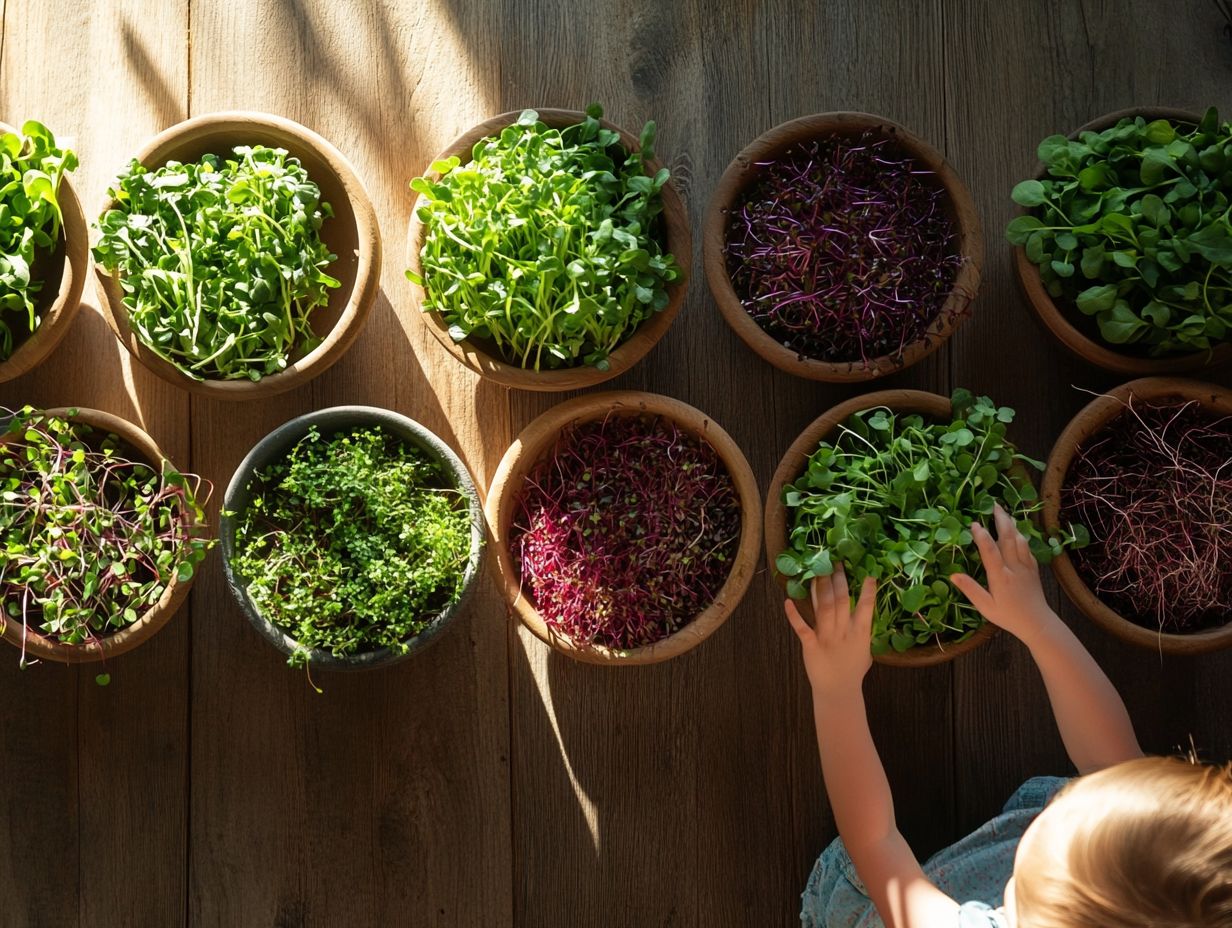
- Microgreens are young, nutrient-dense greens that are smaller in size and more flavorful than their mature counterparts.
- Compared to other greens, microgreens pack a higher concentration of vitamins, minerals, and antioxidants, making them a great addition to kids’ diets.
- Including microgreens in kids’ meals can improve their overall nutrient intake and boost their immune system while providing a fun and educational activity through growing them at home.
What are Microgreens?
Microgreens are young, edible plants harvested just after their first true leaves emerge. They often boast concentrated nutrients along with vibrant flavor profiles.
These nutrient-dense superfoods are increasingly popular in diverse culinary applications. They belong to several plant families, including the Brassicaceae family, which features favorites like broccoli, spinach, and kale.
You ll find them cultivated in various environments, making them accessible and versatile for home cooks and professional chefs alike.
Definition and Types
Microgreens encompass a delightful variety of young vegetables and herbs. They are celebrated for their impressive nutrient density and vibrant flavors, making them a staple in culinary creations.
Among these, broccoli microgreens capture attention with their high sulforaphane content, a natural compound that may help keep your body healthy. Additionally, Cress, with its peppery kick, not only enhances the flavor of your dishes but also serves as a rich source of vitamins A, C, and K, along with dietary fiber that benefits your digestive health. Including such greens is crucial, as you can learn in this article on why microgreens are essential for a balanced diet.
Dandelion microgreens bring a unique taste to the table and are praised for their detoxifying qualities and potential to promote liver health. Incorporating these microgreens into your salads, sandwiches, or smoothies elevates the flavors and embraces a wholesome approach to eating.
Nutritional Value of Microgreens
The nutritional value of microgreens is exceptional; these tiny powerhouses are brimming with concentrated nutrients, vitamins, and healthy elements, making them a remarkable enhancement to your diet.
Comparison to Other Greens
When you compare traditional leafy greens to microgreens, you ll find that these tiny wonders often take the crown in nutrient density and health benefits.
Microgreens deliver a concentrated punch of vitamins and minerals, offering higher levels of essential nutrients per serving than larger counterparts like spinach and Swiss chard.
They are abundant in antioxidants, which help combat harmful substances in the body that can cause damage. Microgreens may also help regulate blood sugar levels by improving insulin sensitivity, making them a smart choice if you’re monitoring those numbers.
Adding microgreens to your diet may contribute to heart disease prevention, thanks to their positive effects on cholesterol levels and blood pressure. Plus, the anti-cancer properties found in microgreens support cellular health, reducing the risk of certain cancers and promoting overall well-being.
Why not try growing your own microgreens at home? It s a fun and engaging activity for the whole family!
Benefits of Microgreens for Kids
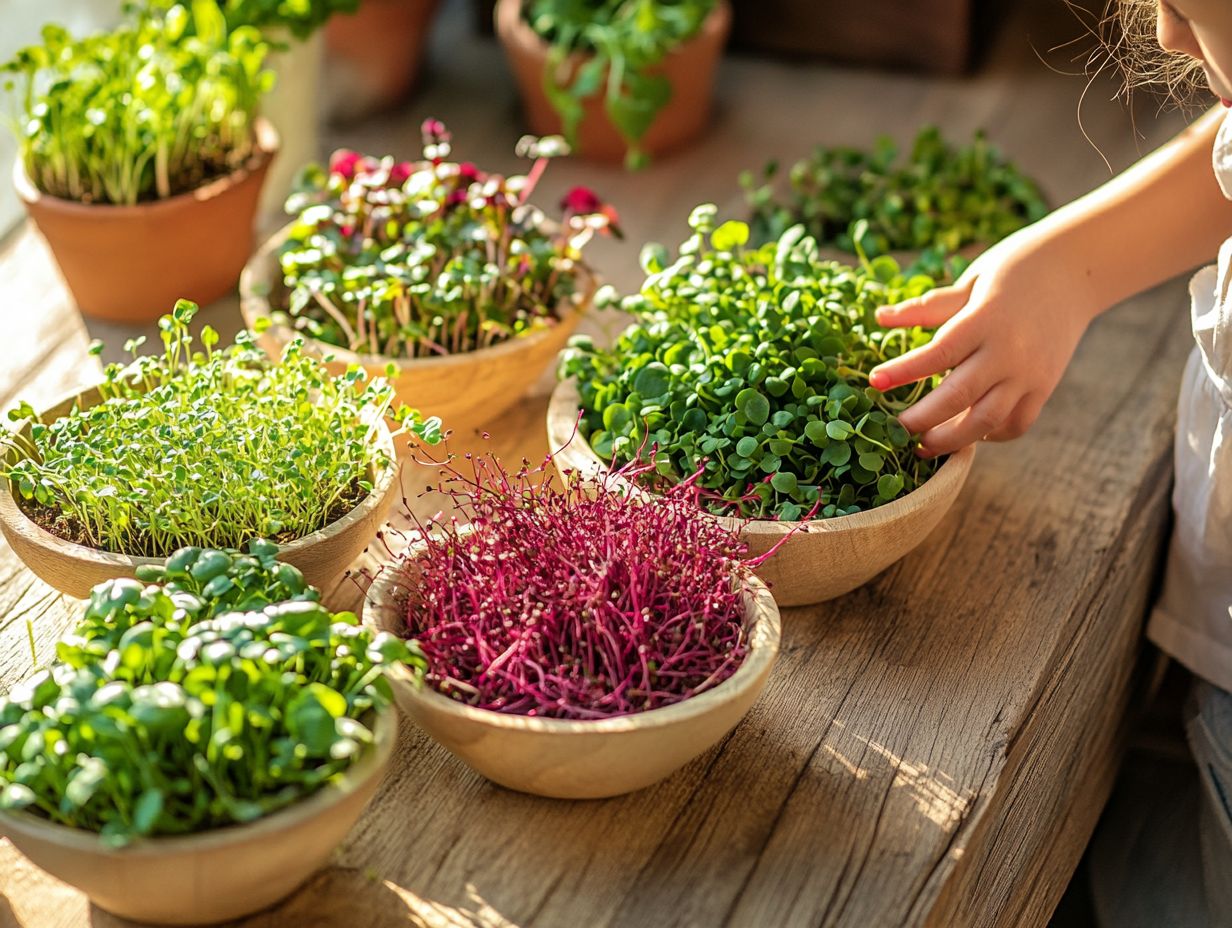
Microgreens offer great benefits for children. They enrich diets with healthy foods that support growth and development, making healthy eating fun!
Improving Nutrient Intake
Incorporating microgreens into your kids’ diets can dramatically enhance their overall nutrient intake. These tiny powerhouses provide concentrated levels of vitamins and minerals.
Packed with essential nutrients like vitamin C, vitamin E, and various B vitamins, microgreens are vital for healthy growth. For instance, tossing a handful of broccoli microgreens into a smoothie or sprinkling pea shoots over a salad can give your children an extra boost of vitamins without them even realizing it! Incorporating microgreens into your meals can enhance your diet, as highlighted in the role of microgreens in healthy eating.
These vibrant greens are also rich in dietary fiber, promoting good gut health. This is crucial for your kids’ digestion and nutrient absorption. By seamlessly integrating microgreens into their meals, you can effortlessly elevate their diets, ensuring they grow strong and healthy.
Boosting Immunity
Microgreens are a powerhouse of antioxidants and essential vitamins. They are fantastic allies in boosting children’s immunity and overall health.
Spinach and broccoli microgreens are full of natural compounds that help boost immunity. These tiny greens are rich in compounds like sulforaphane and vitamins A, C, and E. Together, they combat oxidative stress and inflammation, and understanding the science behind microgreens and health can provide further insights into their benefits.
Don’t miss out! These microgreens can help protect your child’s health now and in the future. Incorporating these nutrient-dense additions into your child’s diet not only enhances their immune defenses but also supports their overall growth and development, as highlighted in why microgreens are superfoods you need.
How to Incorporate Microgreens into Kids’ Diet
Adding microgreens to your kids’ meals is a fun and tasty adventure! These tiny powerhouses can be seamlessly woven into a variety of recipes and meals, transforming healthy eating into an engaging experience for the whole family.
Creative and Kid-Friendly Ideas
Creative and kid-friendly ideas for using microgreens can make healthy eating a fun experience for children. Ensure they enjoy their meals while reaping the nutritional benefits.
Incorporating these vibrant greens into cooking allows kids to explore new flavors and textures. Simple recipes featuring microgreens like adding a handful to smoothies for a refreshing twist, layering them in sandwiches for a satisfying crunch, or tossing them into salads for a nutritional boost invite playful culinary experiments.
Get your kids involved in meal prep! It s a fun way to learn about healthy eating together and creates wonderful opportunities for family bonding.
Growing Microgreens with Kids
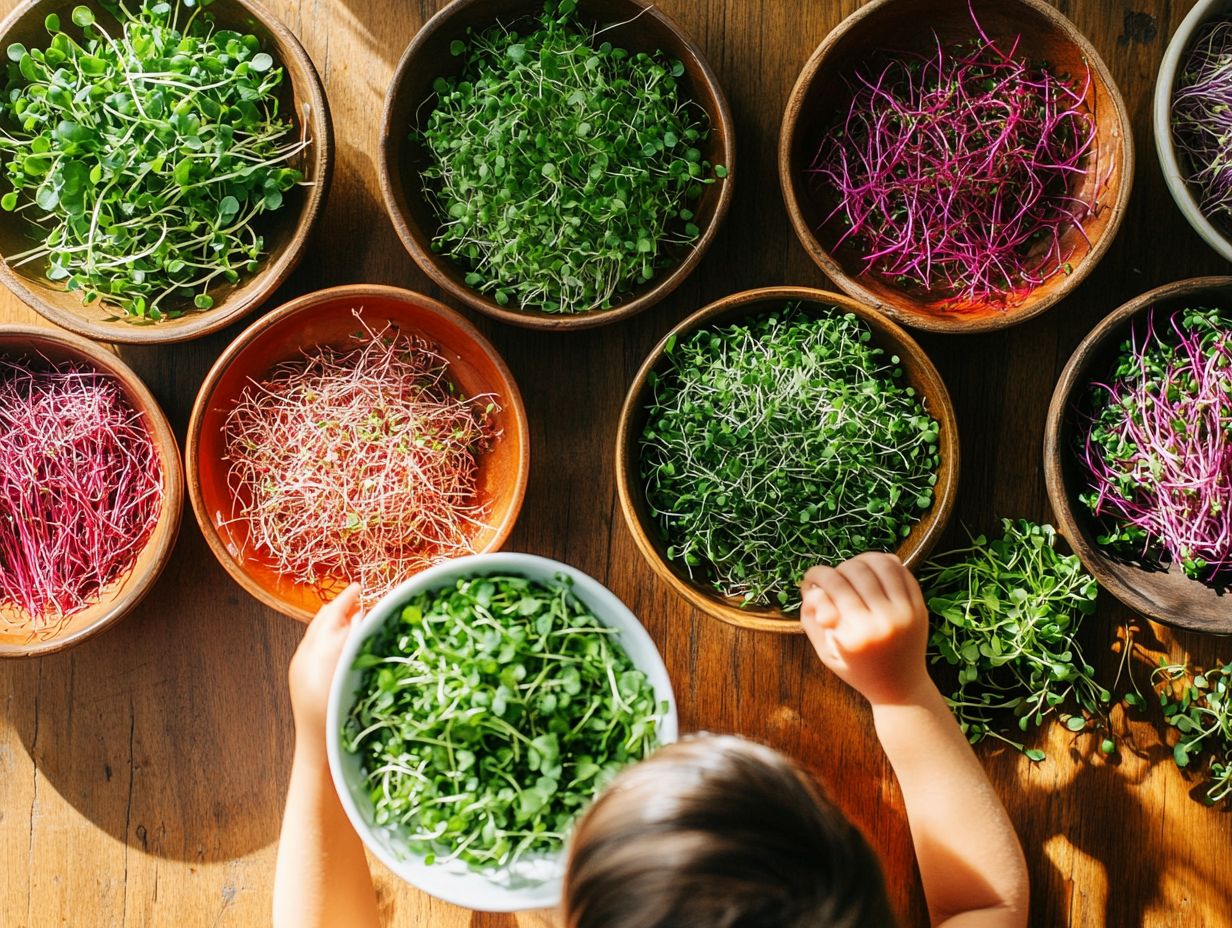
Growing microgreens with children offers a rewarding and educational experience. It nurtures a passion for gardening and sustainable practices.
This engaging activity not only instills valuable lessons about the environment but also provides fresh, nutritious ingredients to enhance meals.
Fun and Educational Activities
Engaging kids in fun and educational activities while growing microgreens can significantly enhance their understanding of plants and nutrition transforming gardening into a delightful family experience!
Introduce a variety of hands-on activities to cultivate curiosity and foster a genuine love for nature. For instance, tracking the growth of each microgreen allows your children to observe daily changes, sparking fascinating discussions about plant biology.
Experiment with unique seeds like Amaranth and Fenugreek to elevate the experience into a delightful culinary adventure. This encourages young gardeners to explore the diverse flavors and textures these plants produce.
Incorporating lessons about nutrition and healthy eating teaches kids the importance of adding greens to their meals, making the entire process educational and deliciously rewarding!
Precautions and Safety Considerations
Growing and consuming microgreens can provide a wealth of health benefits. However, being mindful of food safety precautions ensures a safe and healthy experience.
Guidelines for Growing and Consuming Microgreens
Guidelines for growing and consuming microgreens are essential to ensure safety and maximize health benefits. This makes the experience delightful for you and your family!
Choosing good soil that drains well is crucial for healthy growth; a nutrient-rich mix will yield the best results. Use a spray bottle to mist the seeds, which prevents over-saturation while ensuring adequate moisture.
Providing enough light is crucial. Maintain either natural sunlight or a grow light for about 12 to 16 hours each day. After harvesting these vibrant greens, wash them thoroughly under cool water.
This step removes leftover soil and potential contaminants, safeguarding your family s health and enhancing the enjoyment of these nutrient-dense plants.
Frequently Asked Questions
What are microgreens?

Microgreens are young vegetable greens harvested when they are just a few inches tall. Packed with nutrients, including vitamin A and vitamin K, they are considered a superfood!
Why are microgreens beneficial for kids?
Microgreens are beneficial for kids because they are loaded with essential vitamins, minerals, and antioxidants. They also have a milder taste compared to fully grown vegetables, making them more appealing to kids.
What are the nutritional advantages of microgreens for kids?
Microgreens are rich in vitamins A, C, and K, as well as minerals like iron, potassium, and calcium. These nutrients are crucial for kids’ overall health, including immune function, bone development, and eye health.
Can microgreens be easily incorporated into kids’ diets?
Yes, microgreens can be easily added to kids’ diets! Use them in sandwiches, wraps, salads, smoothies, or as toppings for pizzas and soups. This helps kids consume a variety of nutrients without even realizing it.
Are microgreens safe for kids to consume?
Yes, microgreens are safe for kids! They are grown in a controlled environment without pesticides, making them a healthy choice. However, always wash them thoroughly before consumption.
Are there any specific microgreens that are more beneficial for kids?
While all microgreens offer nutritional benefits, popular varieties for kids include broccoli, kale, and sunflower microgreens. These are rich in vitamins and minerals and have a milder taste that kids may enjoy.
Start incorporating microgreens into your family’s meals today for a healthier lifestyle!

